Lexmark C950 User Manual
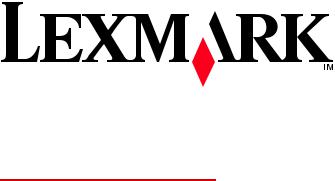
C950 Series
User's Guide
March 2013 |
www.lexmark.com |
|
|
Machine type(s):
5058
Model(s):
030

Contents |
2 |
Contents |
|
Safety information....................................................................................... |
6 |
Learning about the printer........................................................................... |
8 |
Thank you for choosing this printer!......................................................................................................... |
8 |
Finding information about the printer...................................................................................................... |
8 |
Selecting a location for the printer............................................................................................................ |
9 |
Printer configurations............................................................................................................................. |
11 |
Using the printer control panel............................................................................................................... |
14 |
Understanding the home screen................................................................ |
15 |
Understanding the home screen............................................................................................................. |
15 |
Using the touch-screen buttons.............................................................................................................. |
16 |
Setting up and using the home screen applications.................................... |
18 |
Accessing the Embedded Web Server..................................................................................................... |
18 |
Showing or hiding icons on the home screen......................................................................................... |
18 |
Activating the home screen applications................................................................................................ |
19 |
Using Background and Idle Screen ................................................................................................................... |
19 |
Setting up Forms and Favorites ........................................................................................................................ |
19 |
Understanding Eco Settings ............................................................................................................................. |
20 |
Understanding Showroom................................................................................................................................ |
20 |
Setting up Remote Operator Panel................................................................................................................... |
20 |
Exporting and importing a configuration................................................................................................ |
21 |
Additional printer setup............................................................................. |
22 |
Turning on the printer............................................................................................................................. |
22 |
Installing internal options........................................................................................................................ |
23 |
Installing hardware options..................................................................................................................... |
37 |
Attaching cables...................................................................................................................................... |
40 |
Verifying printer setup............................................................................................................................ |
41 |
Setting up the printer software............................................................................................................... |
42 |
Setting up wireless printing..................................................................................................................... |
44 |
Installing the printer on an Ethernet network........................................................................................ |
49 |
Changing port settings after installing a new network Internal Solutions Port...................................... |
52 |
Setting up serial printing......................................................................................................................... |
53 |
Contents |
3 |
Minimizing your printer's environmental impact |
........................................56 |
Saving paper and toner........................................................................................................................... |
56 |
Saving energy.......................................................................................................................................... |
57 |
Recycling.................................................................................................................................................. |
60 |
Loading paper and specialty media............................................................ |
61 |
Setting the paper size and type............................................................................................................... |
61 |
Configuring Universal paper settings...................................................................................................... |
61 |
Loading the standard or optional 520 sheet tray................................................................................... |
61 |
Loading the optional 850 and 1,150 sheet trays................................................................................... |
64 |
Loading the 2000 sheet high capacity feeder......................................................................................... |
67 |
Loading the multipurpose feeder............................................................................................................ |
69 |
Linking and unlinking trays...................................................................................................................... |
72 |
Paper and specialty media guide................................................................ |
75 |
Paper guidelines...................................................................................................................................... |
75 |
Storing paper........................................................................................................................................... |
78 |
Supported paper sizes, types, and weights............................................................................................. |
79 |
Printing...................................................................................................... |
86 |
Printing a document................................................................................................................................ |
86 |
Printing from a mobile device................................................................................................................. |
87 |
Printing from a flash drive....................................................................................................................... |
88 |
Printing on specialty media..................................................................................................................... |
90 |
Printing confidential and other held jobs................................................................................................ |
92 |
Printing information pages...................................................................................................................... |
93 |
Canceling a print job................................................................................................................................ |
94 |
Understanding printer menus.................................................................... |
95 |
Menus list................................................................................................................................................ |
95 |
Supplies menu......................................................................................................................................... |
96 |
Paper menu............................................................................................................................................. |
98 |
Reports menu........................................................................................................................................ |
109 |
Network/Ports menu............................................................................................................................. |
110 |
Security menu....................................................................................................................................... |
124 |
Settings menu........................................................................................................................................ |
128 |
Help menu............................................................................................................................................. |
153 |
Contents |
4 |
Securing the hard disk and other installed memory.................................. |
154 |
Statement of Volatility.......................................................................................................................... |
154 |
Erasing volatile memory........................................................................................................................ |
154 |
Erasing non volatile memory................................................................................................................ |
155 |
Erasing printer hard disk memory......................................................................................................... |
155 |
Configuring printer hard disk encryption.............................................................................................. |
156 |
Maintaining the printer............................................................................ |
157 |
Cleaning the exterior of the printer...................................................................................................... |
157 |
Cleaning the printhead lenses............................................................................................................... |
157 |
Emptying the hole punch box................................................................................................................ |
161 |
Storing supplies..................................................................................................................................... |
163 |
Checking the status of parts and supplies............................................................................................. |
163 |
Ordering parts and supplies.................................................................................................................. |
164 |
Replacing parts and supplies................................................................................................................. |
166 |
Moving the printer................................................................................................................................ |
187 |
Administrative support............................................................................ |
188 |
Finding advanced networking and administrator information............................................................. |
188 |
Checking the virtual display................................................................................................................... |
188 |
Checking the status of the printer......................................................................................................... |
188 |
Setting up e mail alerts......................................................................................................................... |
188 |
Viewing reports..................................................................................................................................... |
189 |
Restoring factory default settings......................................................................................................... |
189 |
Clearing jams............................................................................................ |
190 |
Avoiding jams........................................................................................................................................ |
190 |
Understanding jam numbers and locations.......................................................................................... |
190 |
201–202 paper jams.............................................................................................................................. |
192 |
203 paper jam....................................................................................................................................... |
194 |
230 paper jam....................................................................................................................................... |
195 |
231 paper jam....................................................................................................................................... |
196 |
24x paper jam........................................................................................................................................ |
198 |
250 paper jam....................................................................................................................................... |
204 |
281 paper jam....................................................................................................................................... |
204 |
4yy.xx paper jams.................................................................................................................................. |
206 |

Contents |
5 |
455 staple jam....................................................................................................................................... |
211 |
Troubleshooting....................................................................................... |
214 |
Solving basic printer problems.............................................................................................................. |
214 |
Understanding printer messages.......................................................................................................... |
214 |
Solving printing problems..................................................................................................................... |
228 |
Solving home screen applications problems......................................................................................... |
231 |
Solving option problems........................................................................................................................ |
234 |
Solving paper feed problems................................................................................................................. |
237 |
Solving print quality problems.............................................................................................................. |
238 |
Solving color quality problems.............................................................................................................. |
249 |
Embedded Web Server does not open................................................................................................. |
252 |
Contacting customer support................................................................................................................ |
253 |
Notices..................................................................................................... |
254 |
Product information.............................................................................................................................. |
254 |
Edition notice........................................................................................................................................ |
254 |
Power consumption.............................................................................................................................. |
258 |
Index........................................................................................................ |
269 |
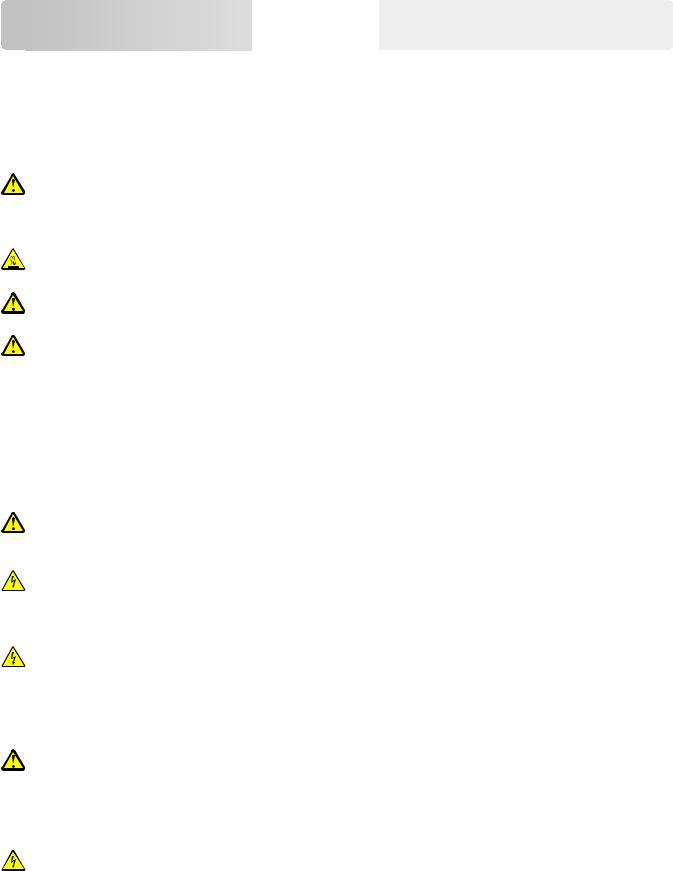
Safety information |
6 |
Safety information





Connect the power cord to a properly grounded electrical outlet that is near the product and easily accessible.
Do not place or use this product near water or wet locations.
This product uses a printing process that heats the print media, and the heat may cause the media to release emissions. You must understand the section in your operating instructions that discusses the guidelines for selecting print media to avoid the possibility of harmful emissions.
CAUTION—POTENTIAL INJURY: The lithium battery in this product is not intended to be replaced. There is a danger of explosion if a lithium battery is incorrectly replaced. Do not recharge, disassemble, or incinerate a lithium battery. Discard used lithium batteries according to the manufacturer's instructions and local regulations.
CAUTION—HOT SURFACE: The inside of the printer might be hot. To reduce the risk of injury from a hot component, allow the surface to cool before touching.
CAUTION—POTENTIAL INJURY: The printer weight is greater than 18 kg (40 lb) and requires two or more trained personnel to lift it safely.
CAUTION—POTENTIAL INJURY: Before moving the printer, follow these guidelines to avoid personal injury or printer damage:
•Turn the printer off using the power switch, and then unplug the power cord from the wall outlet.
•Disconnect all cords and cables from the printer before moving it.
•Lift the printer off the optional drawer, and set it aside instead of trying to lift the drawer and printer at the same time.
Note: Use the handholds located on both sides of the printer to lift it off the optional drawer.
Use only the power cord provided with this product or the manufacturer's authorized replacement.
CAUTION—POTENTIAL INJURY: To reduce risk of fire, use only the telecommunications (RJ 11) cord provided with this product or a UL Listed 26 AWG or larger replacement when connecting this product to the public switched telephone network.
CAUTION—SHOCK HAZARD: If you are accessing the system board or installing optional hardware or memory devices sometime after setting up the printer, then turn the printer off, and unplug the power cord from the wall outlet before continuing. If you have any other devices attached to the printer, then turn them off as well, and unplug any cables going into the printer.
CAUTION—SHOCK HAZARD: Make sure that all external connections (such as Ethernet and telephone system connections) are properly installed in their marked plug-in ports.
This product is designed, tested, and approved to meet strict global safety standards with the use of specific manufacturer's components. The safety features of some parts may not always be obvious. The manufacturer is not responsible for the use of other replacement parts.
CAUTION—POTENTIAL INJURY: Do not cut, twist, bind, crush, or place heavy objects on the power cord. Do not subject the power cord to abrasion or stress. Do not pinch the power cord between objects such as furniture and walls. If any of these things happen, a risk of fire or electrical shock results. Inspect the power cord regularly for signs of such problems. Remove the power cord from the electrical outlet before inspecting it.
Refer service or repairs, other than those described in the user documentation, to a professional service person.
CAUTION—SHOCK HAZARD: To avoid the risk of electric shock when cleaning the exterior of the printer, unplug the power cord from the wall outlet and disconnect all cables from the printer before proceeding.

Safety information |
7 |
CAUTION—SHOCK HAZARD: Do not use the fax feature during a lightning storm. Do not set up this product or make any electrical or cabling connections, such as the fax feature, power cord, or telephone, during a lightning storm.
CAUTION—TIPPING HAZARD: Floor-mounted configurations require additional furniture for stability. You must use either a printer stand or printer base if you are using a high-capacity input tray, a duplex unit and an input option, or more than one input option. If you purchased a multifunction printer (MFP) that scans, copies, and faxes, you may need additional furniture. For more information, see www.lexmark.com/multifunctionprinters.
CAUTION—POTENTIAL INJURY: To reduce the risk of equipment instability, load each paper drawer or tray separately. Keep all other drawers or trays closed until needed.
SAVE THESE INSTRUCTIONS.

Learning about the printer |
8 |
Learning about the printer
printer

Thank you for choosing this printer!
We've worked hard to make sure it will meet your needs.
To start using your new printer right away, use the setup materials that came with the printer, and then skim the User’s Guide to learn how to perform basic tasks. To get the most out of your printer, read the User’s Guide carefully, and make sure you check the latest updates on our Web site.
We're committed to delivering performance and value with our printers, and we want to make sure you're satisfied. If you do encounter any problems along the way, one of our knowledgeable support representatives will be delighted to help you get back on track fast. And if you find something we could do better, please let us know. After all, you are the reason we do what we do, and your suggestions help us do it better.
Finding information about the printer
|
What are you looking for? |
Find it here |
|
|
|
|
|
|
Initial setup instructions: |
Setup documentation—The setup documentation came |
|
|
• |
Connecting the printer |
with the printer and is also available on the Lexmark Web |
|
• Installing the printer software |
site at http://support.lexmark.com. |
|
|
|
||
|
|
|
|
|
Additional setup and instructions for using the printer: |
User's Guide and Quick Reference Guide—The guides are |
|
|
• Selecting and storing paper and specialty media |
available on the Software and Documentation CD. |
|
|
• |
Loading paper |
For updates, visit our Web site at |
|
http://support.lexmark.com. |
||
|
• |
Configuring printer settings |
|
|
|
||
|
• Viewing and printing documents and photos |
|
|
|
• Setting up and using the printer software |
|
|
|
• Configuring the printer on a network |
|
|
|
• Caring for and maintaining the printer |
|
|
|
• Troubleshooting and solving problems |
|
|
|
|
|
|
|
Instructions for: |
Networking Guide—Open the Software and |
|
|
• Connecting the printer to an Ethernet network |
Documentation CD, and then look for Printer and |
|
|
• Troubleshooting printer connection problems |
Software Documentation under the Pubs folder. From |
|
|
the list of publications, click the Networking Guide link. |
||
|
|
|
|
|
|
|
|
|
Help using the printer software |
Windows or Mac Help—Open a printer software program |
|
|
|
|
or application, and then click Help. |
|
|
|
Click ? to view context sensitive information. |
|
|
|
Notes: |
|
|
|
• Help is automatically installed with the printer |
|
|
|
software. |
|
|
|
• The printer software is located in the printer |
|
|
|
program folder or on the desktop, depending on |
|
|
|
your operating system. |
|
|
|
|
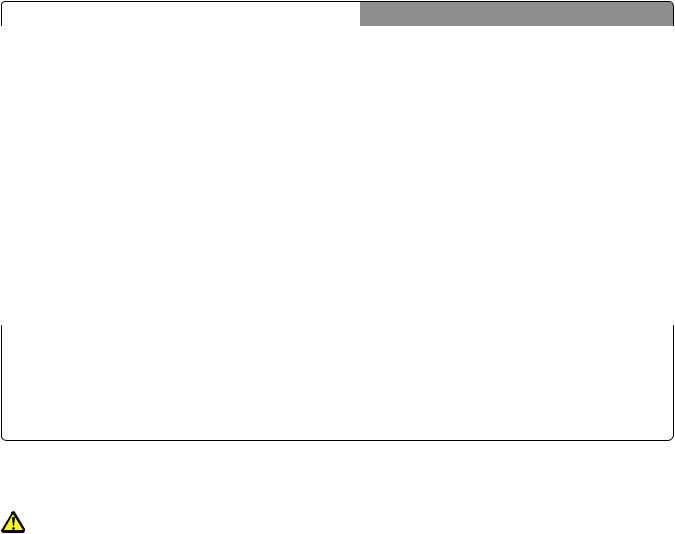
Learning about the printer |
|
9 |
||
|
|
|
|
|
|
What are you looking for? |
Find it here |
||
|
|
|
||
|
The latest supplemental information, updates, and customer |
Lexmark Support Web site— |
||
|
support: |
http://support.lexmark.com |
||
|
• |
Documentation |
Note: Select your country or region, and then select |
|
|
• |
Driver downloads |
your product to view the appropriate support site. |
|
|
• |
Live chat support |
Support telephone numbers and hours of operation for |
|
|
• |
E mail support |
your country or region can be found on the Support Web |
|
|
site or on the printed warranty that came with your |
|||
|
• |
Voice support |
printer. |
|
|
|
|
Record the following information (located on the store |
|
|
|
|
receipt and at the back of the printer), and have it ready |
|
|
|
|
when you contact customer support so that they may |
|
|
|
|
serve you faster: |
|
|
|
|
• |
Machine Type number |
|
|
|
• |
Serial number |
|
|
|
• |
Date purchased |
|
|
|
• |
Store where purchased |
|
|
|
||
|
Warranty information |
Warranty information varies by country or region: |
||
|
|
|
• In the US—See the Statement of Limited Warranty |
|
|
|
|
|
included with this printer, or at |
|
|
|
|
http://support.lexmark.com. |
|
|
|
• In other countries and regions—See the printed |
|
|
|
|
|
warranty that came with your printer. |
|
|
|
|
|
Selecting a location for the printer
CAUTION—POTENTIAL INJURY: The printer weight is greater than 18 kg (40 lb) and requires two or more trained personnel to lift it safely.
When selecting a location for the printer, leave enough room to open trays, covers, and doors. If you plan to install any options, then leave enough room for them also. It is important to:
•Set up the printer near a properly grounded and easily accessible electrical outlet.
•Make sure airflow in the room meets the latest revision of the ASHRAE 62 standard or the CEN Technical Committee 156 standard.
•Provide a flat, sturdy, and stable surface.
•Keep the printer:
–Away from the direct airflow of air conditioners, heaters, or ventilators
–Free from direct sunlight, humidity extremes, or temperature fluctuations
–Clean, dry, and free of dust
–Away from stray staples and paper clips
•Allow the following recommended amount of space around the printer for proper ventilation:
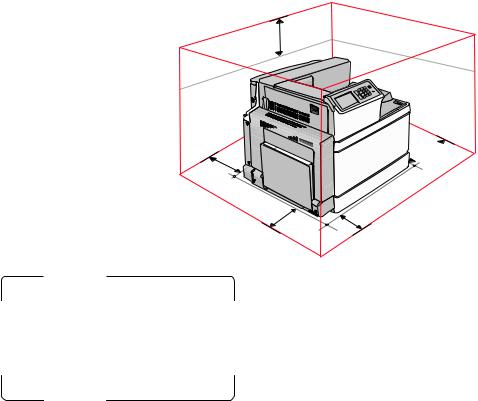
Learning about the printer |
10 |
5












 1 4
1 4 

3 |
2 |
1 |
Right side |
307.34 mm (12.1 in.) |
|
|
|
2 |
Front |
444.5 mm (17.5 in.) |
|
|
|
3 |
Left side |
374.65 mm (14.75 in.) |
|
|
|
4 |
Rear |
100 mm (3.9 in.) |
|
|
|
5 |
Top |
152.4 mm (6 in.) |
|
|
|
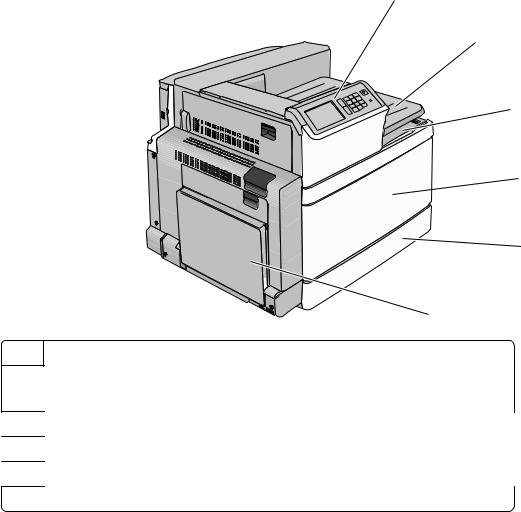
Learning about the printer |
11 |
Printer configurations
Basic model
1
2
3
 4
4
5
6
1 Printer control panel
2Exit tray 2
Note: Exit tray 2 is supported in any configuration except when a finisher is installed.
3Standard exit bin
4Front door
5Standard 520 sheet tray
6 Multipurpose feeder
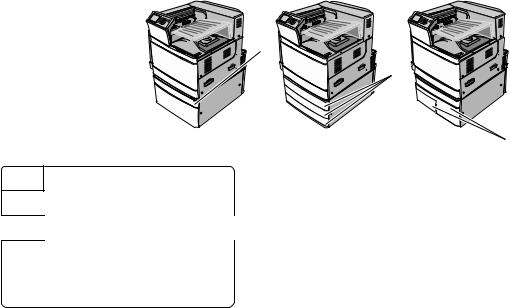
Learning about the printer |
12 |
Configured models
You can configure your basic printer by adding optional trays. A 2,000-sheet high capacity feeder and a finisher bin can also be added.
1
2
 3
3
4
1 Optional 520 sheet tray
2Optional 520 sheet trays
3Optional 520 sheet tray
42,000 sheet tandem tray module
•850 sheet tray (Tray 3)
•1,150 sheet tray (Tray 4)
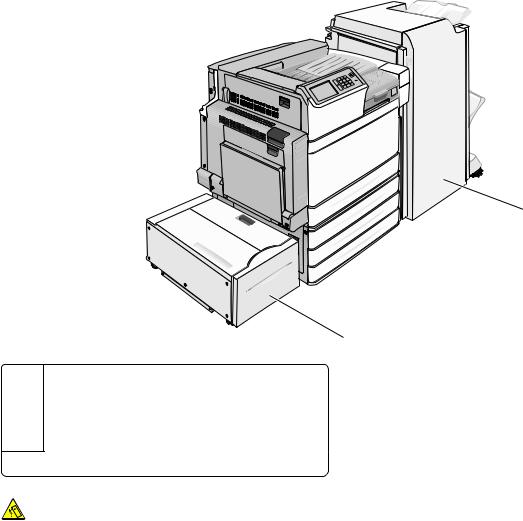
Learning about the printer |
13 |
Fully configured model
1
2
1Finisher bin
The finisher bin can either be one of the following:
•Standard finisher (Punch/Stapler)
•Booklet finisher (Punch/Stapler/Booklet)
2 2,000 sheet high capacity feeder
CAUTION—TIPPING HAZARD: Floor mounted configurations require additional furniture for stability. You must  use either a printer stand or printer base if you are using a high capacity input tray, a duplex unit and an input
use either a printer stand or printer base if you are using a high capacity input tray, a duplex unit and an input
option, or more than one input option. If you purchased a multifunction printer (MFP) that scans, copies, and faxes, you may need additional furniture. For more information, see www.lexmark.com/multifunctionprinters.
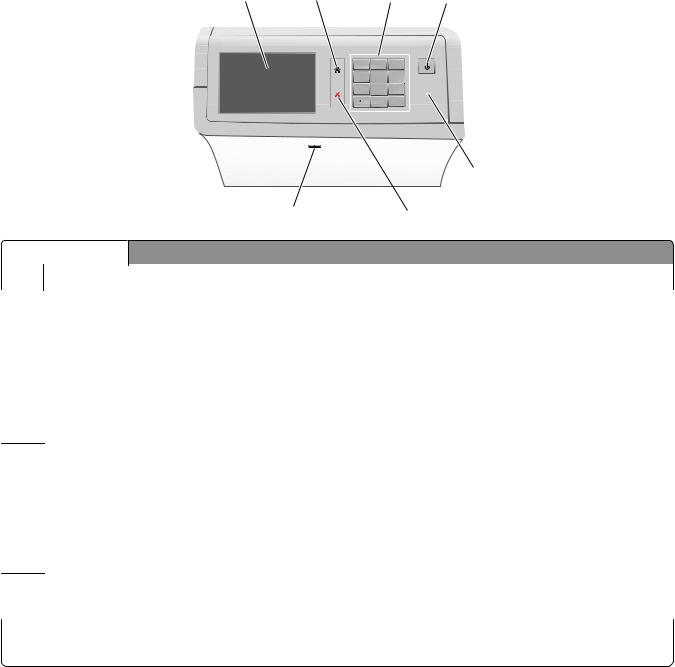
Learning about the printer |
14 |
Using the printer control panel
1 |
2 |
3 |
4 |
1@! 2ABC 3DEF
4GHI 5JKL 6MNO
7PQRS 8TUV 9WXYZ
0 #
#
5
|
|
7 |
6 |
|
|
|
|
Use |
|
To |
|
|
|
|
|
1 |
Display |
View printing options as well as status and error messages. |
|
|
|
|
|
2 |
Home |
Navigate back to the home screen. |
|
|
|
|
|
3 |
Keypad |
Enter numbers, letters, or symbols. |
|
|
|
|
|
4 |
Sleep button |
Enable Sleep Mode or Hibernate Mode. |
|
|
|
• A short press will enable Sleep Mode. |
|
|
|
• A long press will enable Hibernate Mode. |
|
Note: Touching the screen or pressing any hard button will cause the printer to wake from Sleep Mode or Hibernate Mode.
5Indicator light View the status of the printer.
•Off—The printer is off.
•Blinking green—The printer is warming up, processing data, or printing.
•Solid green—The printer is on, but idle.
•Solid red—Operator intervention is needed.
•Amber—The printer enters Sleep Mode or Hibernate Mode.
6 |
Stop/Cancel |
Stop all printer activity. |
|
|
Note: A list of options is displayed once Stopped appears on the display. |
|
|
|
7 |
USB port |
Connect a flash drive into the printer USB port. |
|
|
Note: Only the front USB port supports flash drives. |
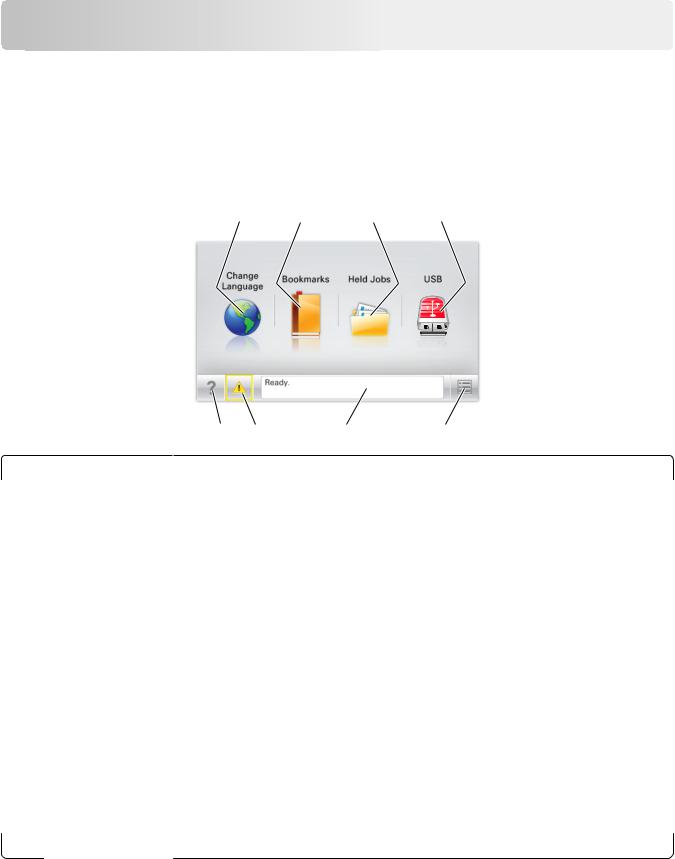
Understanding the home screen |
15 |
Understanding the home screen
the home screen
Understanding the home screen
When the printer is turned on, the display shows a basic screen, referred to as the home screen. Use the home screen buttons and icons to initiate an action.
Note: Your home screen, icons, and the buttons may vary depending on your home screen customization settings, administrative setup, and active embedded solutions.
1 |
2 |
3 |
4 |
123.123.123.123
|
|
|
8 |
7 |
6 |
5 |
|
|
|
|
|
|
|
|
Touch |
|
To |
|
|
|
|
|
|
|
|
||
|
1 |
Change Language |
Change the primary language of the printer. |
|
||
|
|
|
|
|||
|
2 |
Bookmarks |
Create, organize, and save a set of bookmarks (URLs) into a tree view of folders and file links. |
|||
|
|
|
Note: The tree view does not include bookmarks created within Forms and Favorites, and |
|||
|
|
|
the ones in the tree are not usable in Forms and Favorites. |
|||
|
|
|
|
|
|
|
|
3 |
Held Jobs |
Display all current held jobs. |
|
|
|
|
|
|
|
|||
|
4 |
USB or USB |
View, select, or print photos and documents from a flash drive. |
|||
|
|
Thumbdrive |
Note: This icon appears only when you return to the home screen while a memory card or |
|||
|
|
|
||||
|
|
|
flash drive is connected to the printer. |
|
||
|
|
|
|
|
|
|
|
5 |
Menus |
Access printer menus. |
|
|
|
|
|
|
Note: These menus are available only when the printer is in the Ready state. |
|||
|
|
|
|
|||
|
6 |
Status message bar |
• Show the current printer status such as Ready or Busy. |
|||
|
|
|
• Show printer conditions such as Fuser missing or Cartridge Low. |
|||
|
|
|
• Show intervention messages and the instructions on how to clear them. |
|||
|
|
|
|
|||
|
7 |
Status/Supplies |
• Display a warning or error message whenever the printer requires intervention to |
|||
|
|
|
continue processing. |
|
|
|
|
|
|
• Access the messages screen for more information on the message, and how to clear it. |
|||
|
|
|
|
|||
|
8 |
Tips |
Open a context sensitive Help information on the touch screen. |
|||
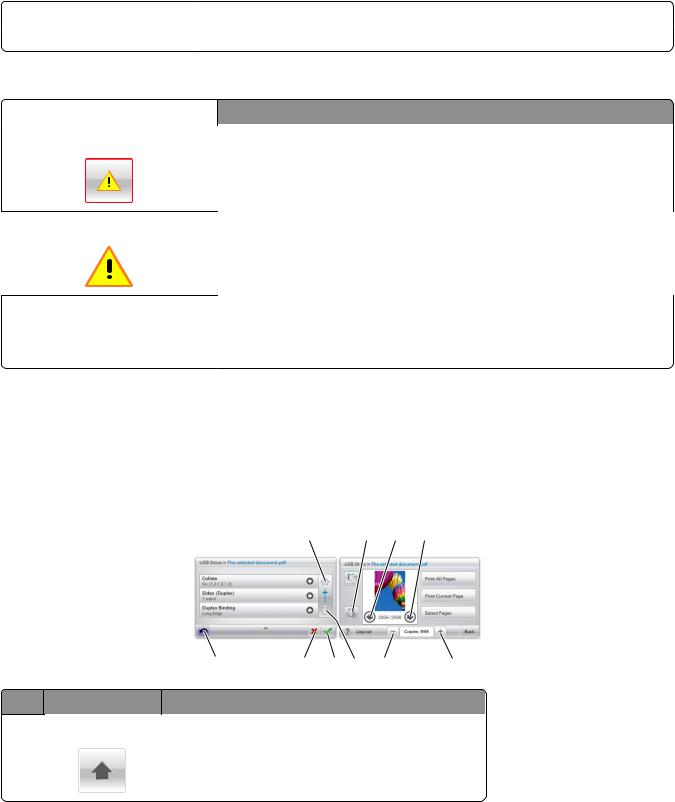
Understanding the home screen |
16 |
This may also appear on the home screen:
Touch |
To |
|
|
Search Held Jobs |
Search current held jobs. |
|
|
Features
Feature |
Description |
|
|
Attendance message alert |
If an attendance message affects a function, then this icon appears and the red |
|
indicator light blinks. |
Warning |
If an error condition occurs, then this icon appears. |
Printer IP address |
The IP address of your network printer is located at the top left corner of the home |
Sample: 123.123.123.123.123 |
screen and appears as four sets of numbers separated by periods. You can use the |
|
IP address when accessing the Embedded Web Server so you can view and remotely |
|
configure printer settings even when you are not physically near the printer. |
Using the touch-screen buttons
Note: Your home screen, icons, and buttons may vary depending on your home screen customization settings, administrative setup, and active embedded solutions.
Sample touch screen
1 |
2 |
3 |
4 |
|
|
10 |
9 |
8 |
7 |
6 |
5 |
|
Touch |
To |
|
|
|
|
|
1 |
Up arrow |
Scroll up. |
|
|
|
|
|

Understanding the home screen |
17 |
||
|
|
|
|
|
Touch |
To |
|
|
|
|
|
2 |
Delete folder |
Delete the file you selected. |
|
3 |
Left arrow |
Scroll to the left. |
4 |
Right arrow |
Scroll to the right. |
5 |
Right scroll increase Scroll to another value in increasing order. |
6 |
Left scroll decrease Scroll to another value in decreasing order. |
||
|
|
|
|
|
|
|
|
7 Down arrow |
Scroll down. |
8 |
Accept |
Save a setting. |
9 |
Cancel |
• |
Cancel an action or a selection. |
|
|
• |
Cancel out a screen and return to the previous screen. |
10 Back |
Navigate back to the previous screen. |

Setting up and using the home screen applications |
18 |
Setting up and using the
and using the home screen applications
home screen applications
Notes:
•Your home screen, icons, and buttons may vary depending on your home screen customization settings, administrative setup, and active embedded applications. Some applications are supported only on select printer models.
•There may be additional solutions and applications available for purchase. To learn more, visit www.lexmark.com. Or, contact the place where you purchased the printer.
Accessing the Embedded Web Server
The Embedded Web Server is the printer Web page that lets you view and remotely configure printer settings even when you are not physically near the printer.
1Obtain the printer IP address:
•From the printer control panel home screen
•From the TCP/IP section in the Network/Ports menu
•By printing a network setup page or menu settings page, and then finding the TCP/IP section
Note: An IP address appears as four sets of numbers separated by periods, such as 123.123.123.123.
2Open a Web browser, and then type the printer IP address in the address field.
3Press Enter.
Note: If you are using a proxy server, then temporarily disable it to load the Web page correctly.
Showing or hiding icons on the home screen
1 Open a Web browser, and then type the printer IP address in the address field.
Note: View the printer IP address on the printer control panel home screen. The IP address appears as four sets of numbers separated by periods, such as 123.123.123.123.
2Click Settings > General Settings > Home screen customization. A list of basic printer functions appears.
3Select the check boxes to specify which icons appear on the printer home screen.
Note: Cleared check box items are hidden.
4Click Submit.
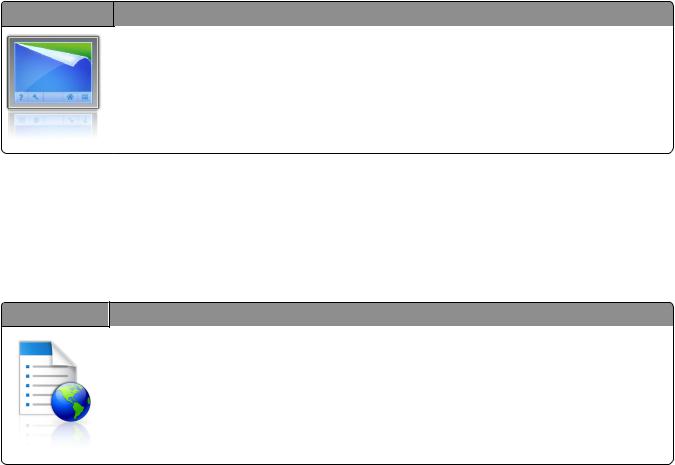
Setting up and using the home screen applications |
19 |
Activating the home screen applications
Your printer comes with preinstalled home screen applications. Before you can use these applications, first activate and set up these applications using the Embedded Web Server. For more information about accessing the Embedded Web Server, see “Accessing the Embedded Web Server” on page 18.
For detailed information about configuring and using the home screen applications, visit the Lexmark Web site at http://support.lexmark.com.
Using Background and Idle Screen
Icon |
Description |
The application lets you customize the background and idle screen of your printer home screen.
1From the home screen, navigate to:
Change Background > select background to use
2Touch  .
.
Setting up Forms and Favorites
Icon |
Description |
The application helps you simplify and streamline work processes by letting you quickly find and print frequently used online forms directly from the home screen.
Note: The printer must have permission to access the network folder, FTP site, or Web site where the bookmark is stored. From the computer where the bookmark is stored, use sharing, security, and firewall settings to allow the printer at least a read access. For help, see the documentation that came with your operating system.
1 Open a Web browser, and then type the printer IP address in the address field.
Note: View the printer IP address on the printer control panel home screen. The IP address appears as four sets of numbers separated by periods, such as 123.123.123.123.
2Click Settings > Device Solutions > Solutions (eSF) > Forms and Favorites.
3Define the bookmarks, and then customize the settings.
4Click Apply.
To use the application, touch Forms and Favorites on the printer home screen, and then navigate through form categories, or search for forms based on a form number, name, or description.
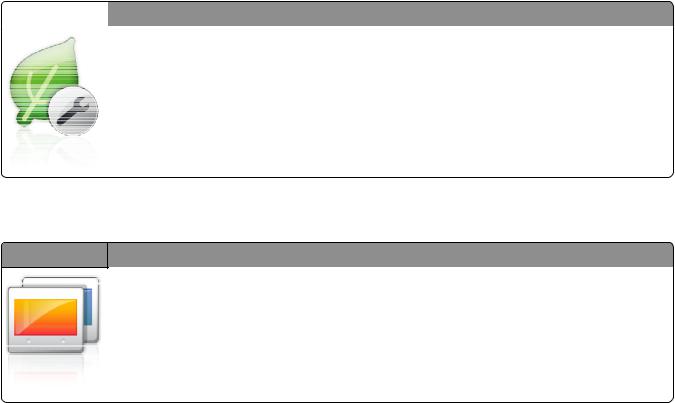
Setting up and using the home screen applications |
20 |
Understanding Eco Settings
Icon |
Description |
||
|
|
|
|
|
|
|
The application lets you easily manage energy consumption, noise, toner, and paper usage settings to |
|
|
|
help reduce the environmental impact of your printer. |
|
|
|
|
|
|
|
|
Understanding Showroom
Icon |
Description |
The application lets you create and display a customized slide show on the touch screen of your printer. You can load images either from a flash drive or through the printer Embedded Web Server.
Setting up Remote Operator Panel
This application shows the printer control panel on your computer screen and lets you interact with the printer control panel, even when you are not physically near the network printer. From your computer screen, you can view the printer status, release held print jobs, create bookmarks, and do other print-related tasks you might normally do while standing at the network printer.
1 Open a Web browser, and then type the printer IP address in the address field.
Note: View the printer IP address on the printer control panel home screen. The IP address appears as four sets of numbers separated by periods, such as 123.123.123.123.
2Click Settings > Device Solutions > Solutions (eSF) > Remote Operator Panel.
3Select the Enabled check box, and then customize the settings.
4Click Apply.
To use the application, from the Embedded Web Server, click Applications > Remote Operator Panel > Launch VNC Applet.
Setting up and using the home screen applications |
21 |
Exporting and importing a configuration
You can export configuration settings into a text file, and then import it to apply the settings to other printers.
Exporting a configuration to a file
1 Open a Web browser, and then type the printer IP address in the address field.
Note: View the printer IP address on the printer control panel home screen. The IP address appears as four sets of numbers separated by periods, such as 123.123.123.123.
2Click Settings or Configuration.
3Click Device Solutions > Solutions (eSF), or click Embedded Solutions.
4From Installed Solutions, click the name of the application you want to configure.
5Click Configure > Export.
6Follow the instructions on the computer screen to save the configuration file, and then type a unique file name or use the default name.
Note: If a JVM Out of Memory error occurs, then repeat the export process until the configuration file is saved.
Importing a configuration from a file
1 Open a Web browser, and then type the printer IP address in the address field.
Note: View the printer IP address on the printer control panel home screen. The IP address appears as four sets of numbers separated by periods, such as 123.123.123.123.
2Click Settings or Configuration.
3Click Device Solutions > Solutions (eSF), or click Embedded Solutions.
4From Installed Solutions, click the name of the application you want to configure.
5Click Configure > Import.
6Browse to the saved configuration file that was exported from a previously configured printer, and then load or preview it.
Note: If a timeout occurs and a blank screen appears, then refresh the Web browser, and then click Apply.
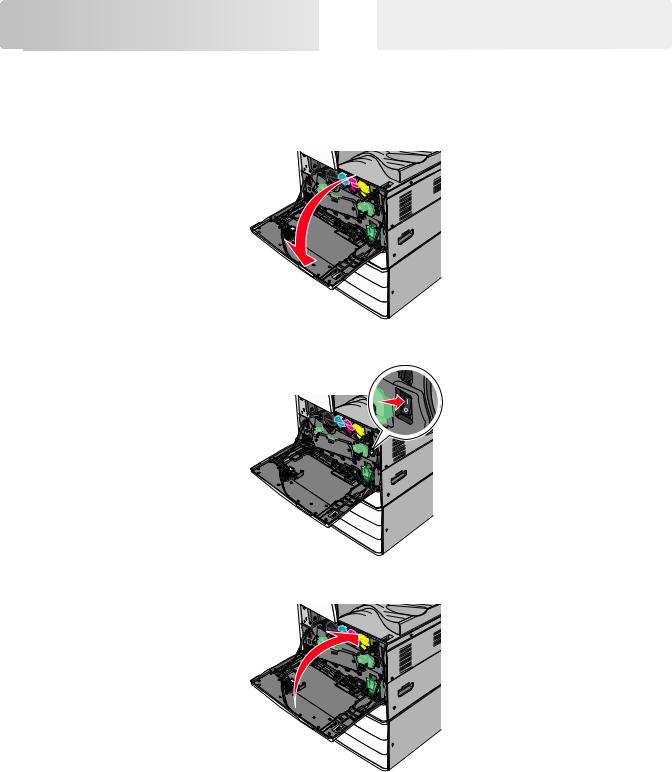
Additional printer setup |
22 |
Additional printer setup


Turning on the printer
1 Open the front door.
2 Press the printer power switch.
3 Close the front door.

Additional printer setup |
23 |
Installing internal options
CAUTION—SHOCK HAZARD: If you are accessing the system board or installing optional hardware or memory devices sometime after setting up the printer, then turn the printer off, and unplug the power cord from the wall outlet before continuing. If you have any other devices attached to the printer, then turn them off as well, and unplug any cables going into the printer.
Available internal options
•Memory cards
–Printer memory
–Flash memory
–Fonts
•Firmware cards
–Bar Code
–PrintCryptionTM
•Printer hard disk
•LexmarkTM Internal Solutions Ports (ISP)
–RS 232 C Serial ISP
–Parallel 1284 B ISP
–MarkNetTM N8250 802.11 b/g/n Wireless ISP
–MarkNet N8130 10/100 Fiber ISP
–MarkNet N8120 10/100/1000 Ethernet ISP
Note: An external kit is needed to support the ISP.
Accessing the system board
CAUTION—SHOCK HAZARD: If you are accessing the system board or installing optional hardware or memory devices sometime after setting up the printer, then turn the printer off, and unplug the power cord from the wall outlet before continuing. If you have any other devices attached to the printer, then turn them off as well, and unplug any cables going into the printer.
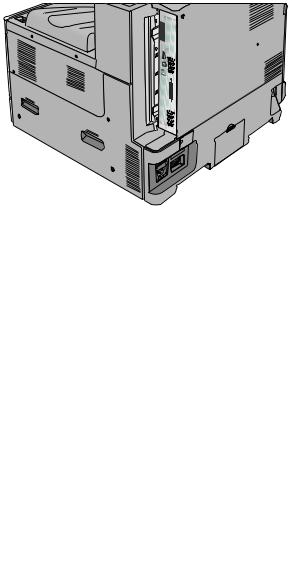
Additional printer setup |
24 |
Note: This task requires a flathead screwdriver.
1 Turn the screws counterclockwise to loosen them.
2 Pull the system board forward to remove it.
3 Use the following illustration to locate the appropriate connectors.
Warning—Potential Damage: System board electronic components are easily damaged by static electricity. Touch something metal on the printer before touching any system board electronic components or connectors.
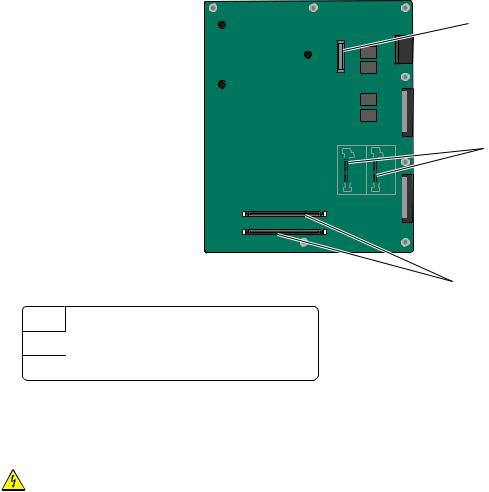
Additional printer setup |
25 |
1
2
3
1 ISP connector
2 Firmware and flash memory card connectors
3 Memory card connectors
4 Push the system board back into place.
Installing a memory card
CAUTION—SHOCK HAZARD: If you are accessing the system board or installing optional hardware or memory devices sometime after setting up the printer, then turn the printer off, and unplug the power cord from the wall outlet before continuing. If you have any other devices attached to the printer, then turn them off as well, and unplug any cables going into the printer.
Warning—Potential Damage: System board electronic components are easily damaged by static electricity. Touch something metal on the printer before touching any system board electronic components or connectors.
An optional memory card can be purchased separately and attached to the system board.
1Access the system board.
For more information, see “Accessing the system board” on page 23.
Note: This task requires a flathead screwdriver.
2 Unpack the memory card.
Note: Avoid touching the connection points along the edge of the card.
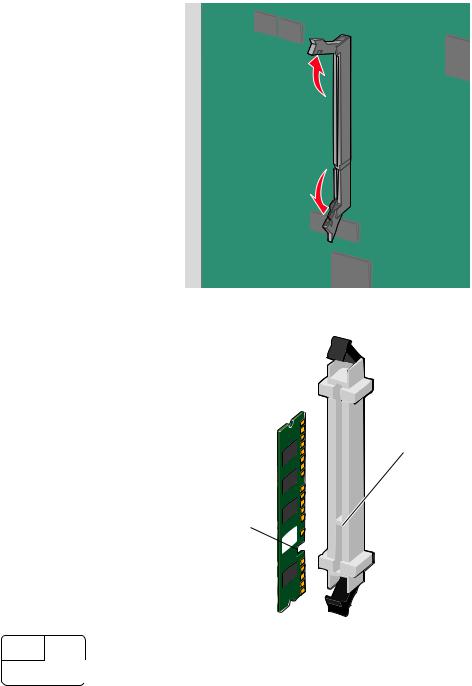
Additional printer setup |
26 |
3 On the system board, open the memory card connector latches.
4 Align the notch on the memory card to the ridge on the connector.
2
1

1 Notch
2 Ridge
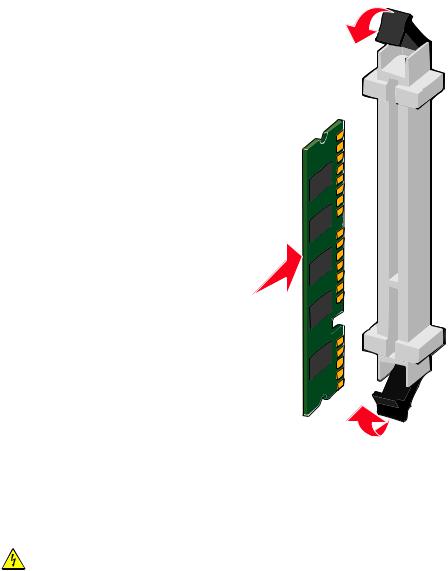
Additional printer setup |
27 |
5 Push the memory card into the connector until it clicks into place.
Installing a flash memory or firmware card
The system board has two connections for an optional flash memory or firmware card. Only one of each may be installed, but the connectors are interchangeable.
CAUTION—SHOCK HAZARD: If you are accessing the system board or installing optional hardware or memory devices sometime after setting up the printer, then turn the printer off, and unplug the power cord from the wall outlet before continuing. If you have any other devices attached to the printer, then turn them off as well, and unplug any cables going into the printer.
Warning—Potential Damage: System board electronic components are easily damaged by static electricity. Touch something metal on the printer before touching any system board electronic components or connectors.
1Access the system board.
For more information, see “Accessing the system board” on page 23.
Notes:
•This task requires a flathead screwdriver.
•Do not unplug the fan cable upon opening the metal panel.
2Unpack the card.
Note: Avoid touching the connection points along the edge of the card.
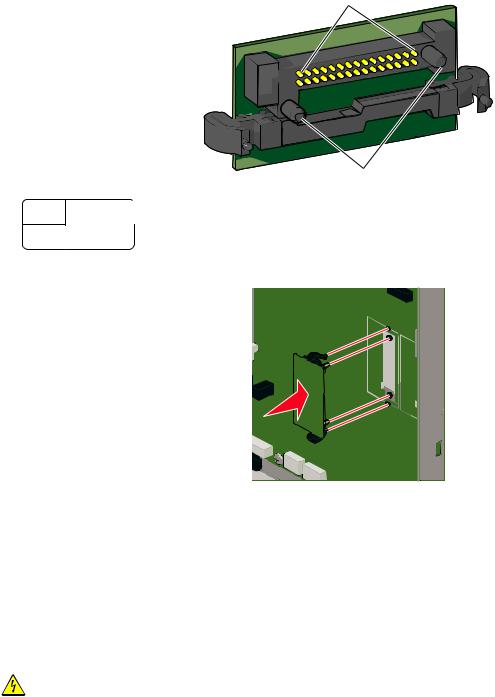
Additional printer setup |
28 |
3 Holding the card by its sides, align the plastic pins on the card with the holes on the system board.
2
1
1 Plastic pins
2 Metal pins
4 Push the card firmly into place.
Notes:
•The entire length of the connector on the card must touch and be flush against the system board.
•Be careful not to damage the connectors.
Installing an Internal Solutions Port
The system board supports one optional Lexmark Internal Solutions Port (ISP).
Note: This task requires a flathead screwdriver.
CAUTION—SHOCK HAZARD: If you are accessing the system board or installing optional hardware or memory devices sometime after setting up the printer, then turn the printer off, and unplug the power cord from the wall outlet before continuing. If you have any other devices attached to the printer, then turn them off as well, and unplug any cables going into the printer.
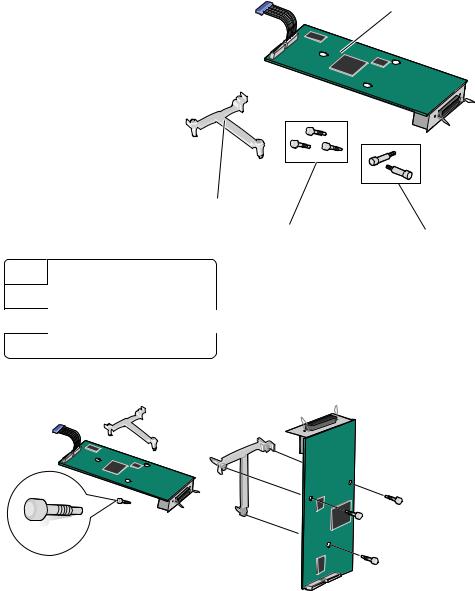
Additional printer setup |
29 |
Warning—Potential Damage: System board electronic components are easily damaged by static electricity. Touch something metal on the printer before touching any system board electronic components or connectors.
1Access the system board.
For more information, see “Accessing the system board” on page 23.
2Remove the printer hard disk.
For more information, see “Removing a printer hard disk” on page 35
3Unpack the ISP kit.
1
4
3 |
2 |
|
1 ISP solution
2Screws for the ISP solution
3Screws for the plastic bracket
4 Plastic bracket
4 Use the provided screws to attach the plastic bracket to the ISP solution.
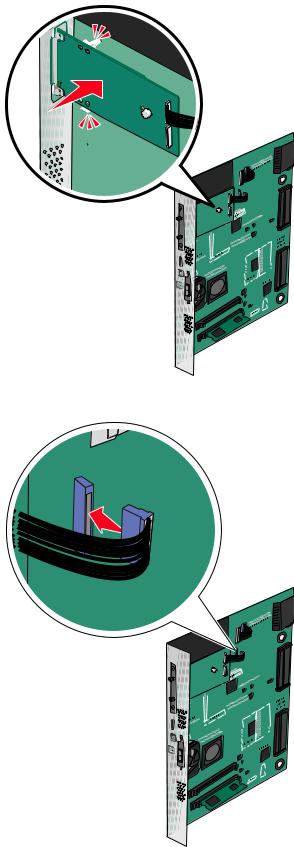
Additional printer setup |
30 |
5 Use the provided screw to attach the ISP solution to the system board cage.
6 Connect the ISP solution interface cable into the receptacle of the system board.
